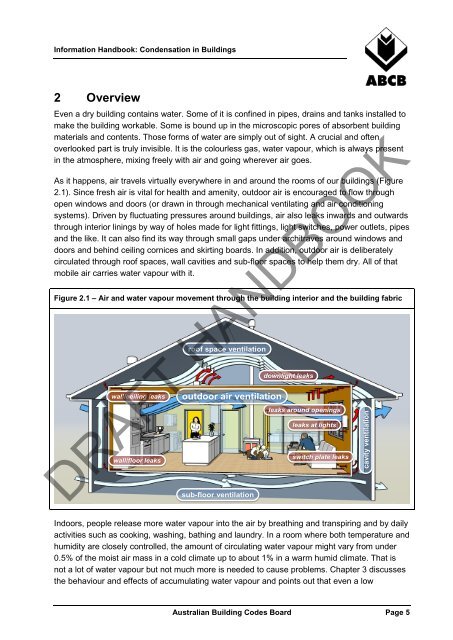Condensation in Buildings - Australian Building Codes Board
Condensation in Buildings - Australian Building Codes Board
Condensation in Buildings - Australian Building Codes Board
You also want an ePaper? Increase the reach of your titles
YUMPU automatically turns print PDFs into web optimized ePapers that Google loves.
Information Handbook: <strong>Condensation</strong> <strong>in</strong> Build<strong>in</strong>gs<br />
2 Overview<br />
Even a dry build<strong>in</strong>g conta<strong>in</strong>s water. Some of it is conf<strong>in</strong>ed <strong>in</strong> pipes, dra<strong>in</strong>s and tanks <strong>in</strong>stalled to<br />
make the build<strong>in</strong>g workable. Some is bound up <strong>in</strong> the microscopic pores of absorbent build<strong>in</strong>g<br />
materials and contents. Those forms of water are simply out of sight. A crucial and often<br />
overlooked part is truly <strong>in</strong>visible. It is the colourless gas, water vapour, which is always present<br />
<strong>in</strong> the atmosphere, mix<strong>in</strong>g freely with air and go<strong>in</strong>g wherever air goes.<br />
As it happens, air travels virtually everywhere <strong>in</strong> and around the rooms of our build<strong>in</strong>gs (Figure<br />
2.1). S<strong>in</strong>ce fresh air is vital for health and amenity, outdoor air is encouraged to flow through<br />
open w<strong>in</strong>dows and doors (or drawn <strong>in</strong> through mechanical ventilat<strong>in</strong>g and air condition<strong>in</strong>g<br />
systems). Driven by fluctuat<strong>in</strong>g pressures around build<strong>in</strong>gs, air also leaks <strong>in</strong>wards and outwards<br />
through <strong>in</strong>terior l<strong>in</strong><strong>in</strong>gs by way of holes made for light fitt<strong>in</strong>gs, light switches, power outlets, pipes<br />
and the like. It can also f<strong>in</strong>d its way through small gaps under architraves around w<strong>in</strong>dows and<br />
doors and beh<strong>in</strong>d ceil<strong>in</strong>g cornices and skirt<strong>in</strong>g boards. In addition, outdoor air is deliberately<br />
circulated through roof spaces, wall cavities and sub-floor spaces to help them dry. All of that<br />
mobile air carries water vapour with it.<br />
Figure 2.1 – Air and water vapour movement through the build<strong>in</strong>g <strong>in</strong>terior and the build<strong>in</strong>g fabric<br />
wall/ceil<strong>in</strong>g leaks<br />
wall/floor leaks<br />
roof space ventilation<br />
outdoor air ventilation<br />
sub-floor ventilation<br />
downlight leaks<br />
leaks around open<strong>in</strong>gs<br />
leaks at lights<br />
switch plate leaks<br />
DRAFT HANDBOOK<br />
Indoors, people release more water vapour <strong>in</strong>to the air by breath<strong>in</strong>g and transpir<strong>in</strong>g and by daily<br />
activities such as cook<strong>in</strong>g, wash<strong>in</strong>g, bath<strong>in</strong>g and laundry. In a room where both temperature and<br />
humidity are closely controlled, the amount of circulat<strong>in</strong>g water vapour might vary from under<br />
0.5% of the moist air mass <strong>in</strong> a cold climate up to about 1% <strong>in</strong> a warm humid climate. That is<br />
not a lot of water vapour but not much more is needed to cause problems. Chapter 3 discusses<br />
the behaviour and effects of accumulat<strong>in</strong>g water vapour and po<strong>in</strong>ts out that even a low<br />
cavity ventilation<br />
<strong>Australian</strong> Build<strong>in</strong>g <strong>Codes</strong> <strong>Board</strong> Page 5
















